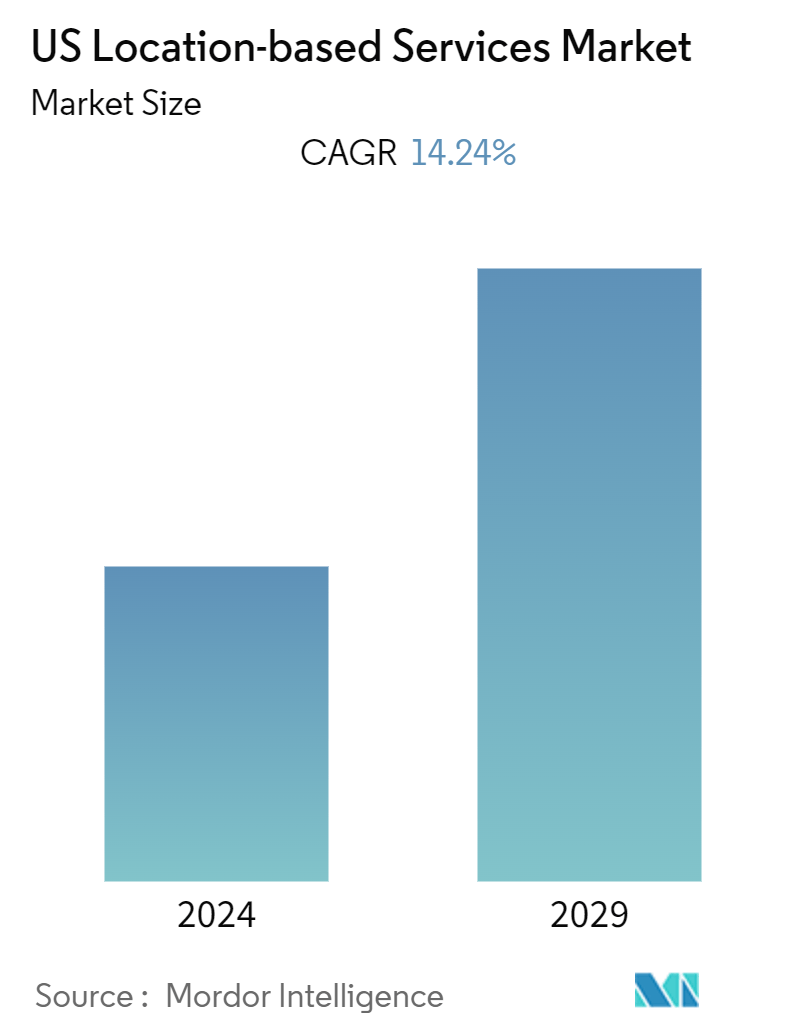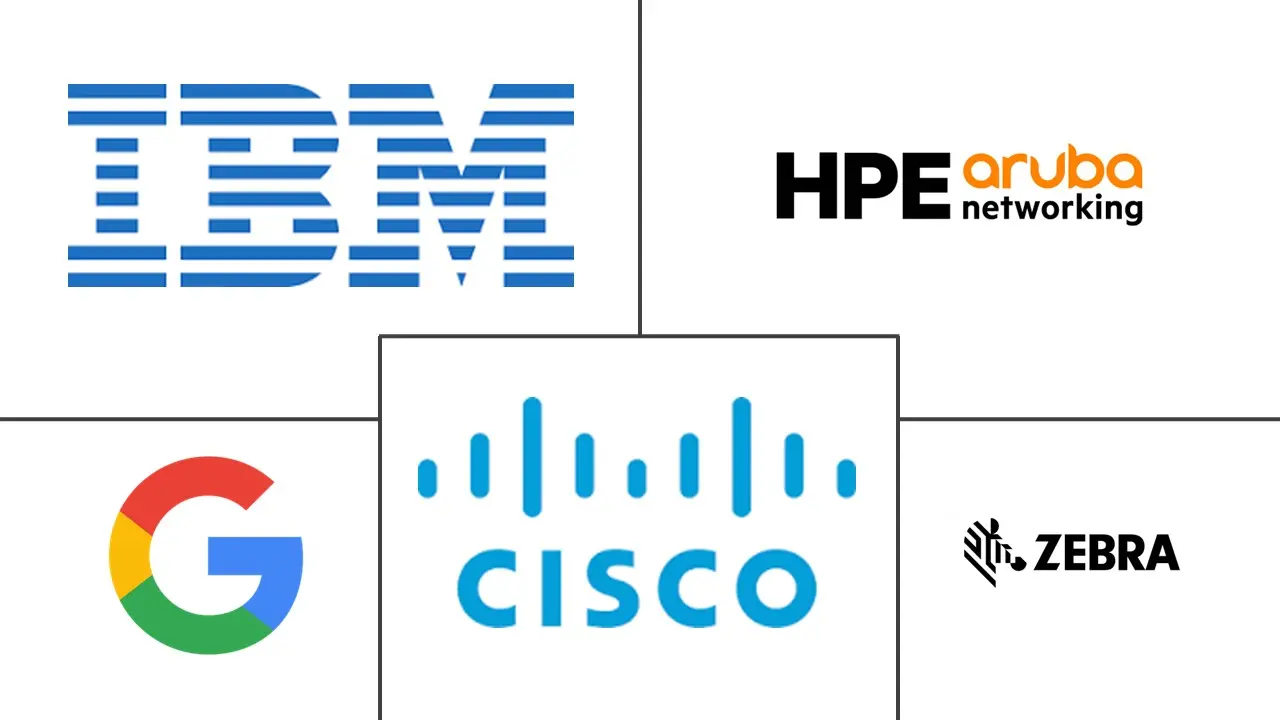Market Size of US Location-based Services Industry

| Study Period | 2019 - 2029 |
| Base Year For Estimation | 2023 |
| Forecast Data Period | 2024 - 2029 |
| Historical Data Period | 2019 - 2022 |
| CAGR (2024 - 2029) | 14.24 % |
| Market Concentration | Medium |
Major Players
*Disclaimer: Major Players sorted in no particular order |
US Location-based Services Market Analysis
The US Location-based Services Market is expected to register a CAGR of 14.24% during the forecast period.
The location-based services (LBS) have emerged significantly in the United States during the past few years. It is increasingly used for locating friends in an area, locating the nearest hotels, or advertising deals to shoppers nearby. Location-based services give users access to relevant and up-to-date details about their surroundings and entitle companies to update their consumers regarding their orders. All these LBS applications offer a dynamic user experience, providing a convenient method for interacting with business enterprises and customers.
- The United States is expected to be one of the largest markets for location-based services worldwide. This North American region is one of the significant markets for smartphones and tablets and in-vehicle navigation systems, as well as the largest producer of aircraft and aerospace and maritime navigation products. The US commands a major share in the North American region in almost all end-user industries, especially in the consumer electronics market.
- The country is also witnessing various innovations and experimentation in the automotive sector. The emergence of autonomous vehicles is expected to fuel the demand for 3D mapping solutions. These self-driving cars are likely to see the nearby environment to know the localities where they can and cannot drive, detect other vehicles on the road, stop pedestrians, and handle any unexpected circumstances they may encounter.
- When it comes to end-users, nearly half of US retailers utilize location-based deals, according to the Factual Location-based Marketing Report. It assists them in attracting customers to their retail establishments at the appropriate moment. It's challenging to stay in touch with consumers who are always on the move. Location-based marketing acts as a link between consumers and retailers. Consumers may receive real-time push notifications, emails, and alerts at the correct time. It's a great approach to reach out to people at a time when they're most likely to respond. For example, Walgreens uses geofencing to promote customer loyalty by pushing a notification that allows users to open their app every time they enter the geofenced area. The user can further view promotional offers by looking at their account details.
- The fastest-developing positioning methods are based on a combination of mobile positioning and satellite-based global positioning systems (GPS). With more widespread methods, like cell global identity (CGICTA) and enhanced observed time difference (E-OTD), the practical precision falls in the 50-1000 m range. These technologies create opportunities for the end-users based on the accuracy needed for specific applications' location identification. Location can be determined using E-OTD, observed timed difference of arrival (OTDOA), wireless-assisted GNSS (A-GNSS), and hybrid technologies, which combine A-GNSS with other standard technologies.
- On the contrary, location-based services are revolutionizing various businesses where resource efficiency is crucial. Individuals' positions may be tracked at all times, and LBS gives the visibility needed to keep people safe. As a result, data security and privacy become increasingly important for users, as misuse might result in disastrous consequences. The frequency of data breaches has risen considerably in recent years due to various applications defying restrictions to gain access to a user's location without their authorization.
US Location-based Services Industry Segmentation
Location-based services (LBSs) are computer or mobile apps that deliver information depending on the user's and the device's location. They are often accessed through mobile networks and portable devices like smartphones.
The precision of the location services majorly depends on the software and hardware utilized in the mobile communication system, along with the positioning server. The US location-based services market is segmented by component (hardware, software, and services), by location (indoor and outdoor), by application (mapping and navigation, business intelligence and analytics, location-based advertising, social networking and entertainment, and other applications), by end-user (transportation and logistics, IT and telecom, healthcare, government, BFSI, hospitality, manufacturing, and other end-users).
The market sizes and forecasts are provided in terms of value USD for all the above segments.
| By Component | |
| Hardware | |
| Software | |
| Services |
| By Location | |
| Indoor | |
| Outdoor |
| By Application | |
| Mapping and Navigation | |
| Business Intelligence and Analytics | |
| Location-based Advertising | |
| Social Networking and Entertainment | |
| Other Applications |
| By End-User | |
| Transportation and Logistics | |
| IT and Telecom | |
| Healthcare | |
| Government | |
| BFSI | |
| Hospitality | |
| Manufacturing | |
| Other End-Users |
US Location-based Services Market Size Summary
The United States location-based services market is experiencing significant growth, driven by the increasing adoption of smartphones, tablets, and in-vehicle navigation systems. These services are becoming integral in various sectors, offering dynamic user experiences by providing real-time information about surroundings and facilitating interactions between businesses and consumers. The market is characterized by the integration of advanced technologies such as mobile positioning and satellite-based GPS, enhancing the accuracy and application of location-based services. The automotive sector, particularly with the rise of autonomous vehicles, is expected to further propel the demand for 3D mapping solutions, highlighting the market's potential across diverse industries.
In addition to automotive advancements, the healthcare and e-commerce sectors are also contributing to the market's expansion. Location-based services are being increasingly utilized for patient tracking and process management in healthcare, while e-commerce platforms leverage these services for personalized marketing and efficient delivery solutions. The market is witnessing a surge in indoor location-based services, facilitated by sensor technology and Bluetooth beacons, which are enhancing navigation and marketing capabilities within large facilities. The competitive landscape is marked by strategic partnerships and technological innovations, with key players like IBM, Cisco, and Google actively investing in developing cutting-edge solutions to maintain their market positions.
US Location-based Services Market Size - Table of Contents
-
1. MARKET INSIGHTS
-
1.1 Market Overview
-
1.2 Industry Attractiveness - Porter's Five Forces Analysis
-
1.2.1 Bargaining Power of Buyers
-
1.2.2 Bargaining Power of Suppliers
-
1.2.3 Threat of New Entrants
-
1.2.4 Threat of Substitutes
-
1.2.5 Intensity of Competitive Rivalry
-
-
1.3 Industry Value Chain Analysis
-
1.4 Assessment of the Impact of COVID-19 on the Market
-
-
2. MARKET SEGMENTATION
-
2.1 By Component
-
2.1.1 Hardware
-
2.1.2 Software
-
2.1.3 Services
-
-
2.2 By Location
-
2.2.1 Indoor
-
2.2.2 Outdoor
-
-
2.3 By Application
-
2.3.1 Mapping and Navigation
-
2.3.2 Business Intelligence and Analytics
-
2.3.3 Location-based Advertising
-
2.3.4 Social Networking and Entertainment
-
2.3.5 Other Applications
-
-
2.4 By End-User
-
2.4.1 Transportation and Logistics
-
2.4.2 IT and Telecom
-
2.4.3 Healthcare
-
2.4.4 Government
-
2.4.5 BFSI
-
2.4.6 Hospitality
-
2.4.7 Manufacturing
-
2.4.8 Other End-Users
-
-
US Location-based Services Market Size FAQs
What is the current US Location-based Services Market size?
The US Location-based Services Market is projected to register a CAGR of 14.24% during the forecast period (2024-2029)
Who are the key players in US Location-based Services Market?
IBM Corporation, Cisco Systems Inc., Google LLC, HPE Aruba Inc and Zebra Technologies Corporation are the major companies operating in the US Location-based Services Market.

